- Home
- Chi siamo
- Settore
- Servizi
- Lettura
- Contattaci
Mercato dei Riempitivi per Vuoti Ossei: Analisi Attuale e Previsioni (2024-2032)
Enfasi sul tipo (Osso demineralizzato, Matrice di collagene, Solfato di calcio della matrice, Fosfato tricalcico); Forma (Granuli di gel, Mastice in pasta e altri); Utente finale (Ospedali, Cliniche specialistiche e altri); e Regione/Paese
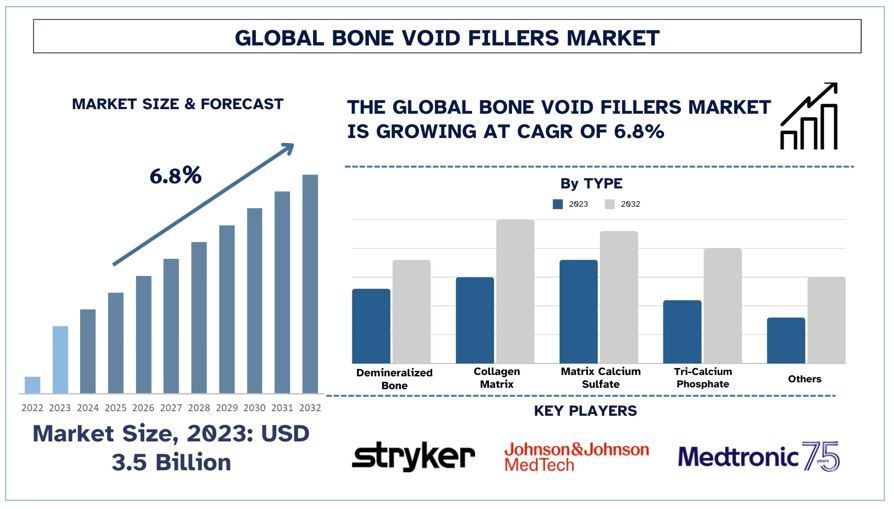 Dimensioni e previsioni del mercato dei riempitivi per difetti ossei
Dimensioni e previsioni del mercato dei riempitivi per difetti ossei
Il mercato dei riempitivi per difetti ossei è stato valutato a circa 3,5 miliardi di dollari nel 2023 e si prevede che crescerà a un CAGR sostanziale di circa il 6,8% durante il periodo di previsione (2024-2032) a causa della crescente prevalenza di condizioni di dolore cronico come l'artrite e il mal di schiena, portando a una maggiore domanda di farmaci per la gestione del dolore come i riempitivi per difetti ossei.
Analisi del mercato dei riempitivi per difetti ossei
I riempitivi per difetti ossei sono biomateriali utilizzati per riempire difetti o vuoti nelle ossa causati da traumi, tumori o malattie degenerative. Promuovono la rigenerazione e l'integrazione ossea fornendo un'impalcatura per la crescita di nuovo osso. Questi materiali possono essere sintetici o derivati da fonti naturali come l'osso demineralizzato. Svolgono un ruolo fondamentale negli interventi di chirurgia ortopedica e ricostruttiva, migliorando i risultati della guarigione e ripristinando l'integrità scheletrica.
Il mercato dei riempitivi per difetti ossei è destinato a crescere con l'invecchiamento della popolazione globale e l'aumento dell'incidenza dei disturbi ortopedici. Questa espansione crea opportunità per i produttori di sviluppare nuovi prodotti ed espandere la propria presenza geografica. Inoltre, la crescente innovazione nei biomateriali e nei processi di produzione sarà fondamentale per le aziende che desiderano differenziare i propri prodotti in un mercato competitivo. Nell'ottobre 2023, Orthofix Medical Inc., azienda leader a livello mondiale nel settore della colonna vertebrale e dell'ortopedia, ha annunciato l'autorizzazione 510k e il lancio commerciale completo di OsteoCove, un innesto sintetico bioattivo avanzato. Disponibile sia in configurazione di stucco che di striscia, OsteoCove è stato attentamente formulato per fornire capacità di formazione ossea superiori con le migliori caratteristiche di manipolazione della categoria per un'ampia gamma di applicazioni procedurali spinali e ortopediche. Inoltre, le collaborazioni tra operatori del settore, istituzioni accademiche e organizzazioni di ricerca aumentano l'innovazione e accelerano lo sviluppo di nuovi riempitivi per difetti ossei. Tali partnership possono anche facilitare le approvazioni normative e l'accesso al mercato.
Tendenze del mercato dei riempitivi per difetti ossei
Questa sezione discute le principali tendenze del mercato che influenzano i vari segmenti del mercato dei riempitivi per difetti ossei, come identificato dai nostri esperti di ricerca.
I riempitivi per difetti ossei demineralizzati trasformano il settore
L'osso demineralizzato ha detenuto una quota di mercato dominante nel 2023. Ciò è dovuto alle sue proprietà biologiche uniche e alle sue versatili applicazioni nella chirurgia ortopedica e spinale. Con la crescita della domanda di procedure minimamente invasive e materiali biocompatibili, l'osso demineralizzato rimane una pietra angolare nell'espansione del mercato dei riempitivi per difetti ossei. Ad esempio, nell'ottobre 2022, Orthofix Medical Inc. ha annunciato il lancio sul mercato completo e i primi impianti di Legacy Demineralized Bone Matrix (DBM), uno stucco per riempire vuoti o lacune nei difetti ossei o nelle lesioni traumatiche della colonna vertebrale, del bacino o delle estremità. Inoltre, i chirurghi preferiscono l'osso demineralizzato grazie alle sue proprietà osteoconduttive e osteoinduttive, che forniscono supporto strutturale e stimolano la crescita di nuovo osso.
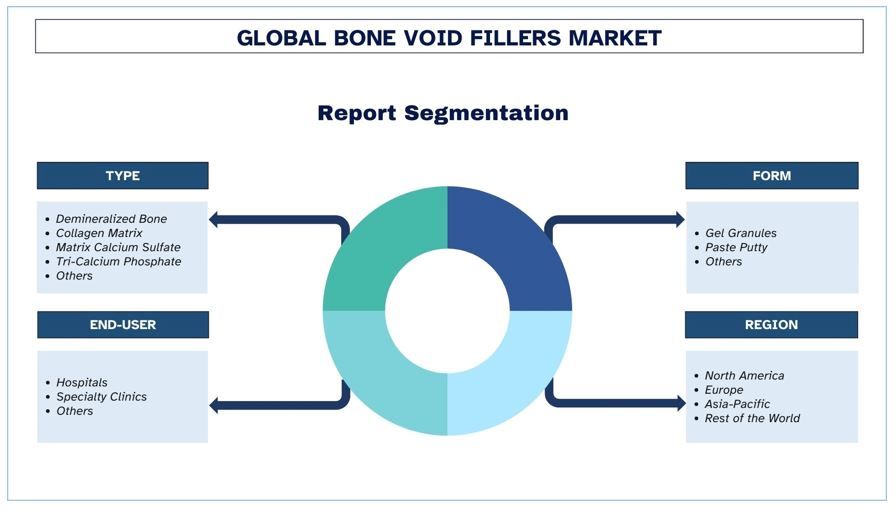
Il Nord America è leader nel mercato nel 2023.
Il mercato nordamericano ha dominato il mercato dei riempitivi per difetti ossei nel 2023 a causa della crescente preferenza del Nord America per le tecniche chirurgiche minimamente invasive, guidata dalla domanda dei pazienti di tempi di recupero più rapidi e degenze ospedaliere ridotte. I riempitivi per difetti ossei sono fondamentali in queste procedure in quanto forniscono supporto strutturale e promuovono la rigenerazione ossea senza richiedere interventi chirurgici aperti estesi. Inoltre, stabilire solide reti di distribuzione e partnership con distributori e strutture sanitarie in tutto il Nord America sarà fondamentale per la penetrazione nel mercato e per raggiungere efficacemente il pubblico di destinazione. Inoltre, il Nord America attrae pazienti da tutto il mondo per procedure ortopediche specializzate, contribuendo alla domanda di riempitivi per difetti ossei.
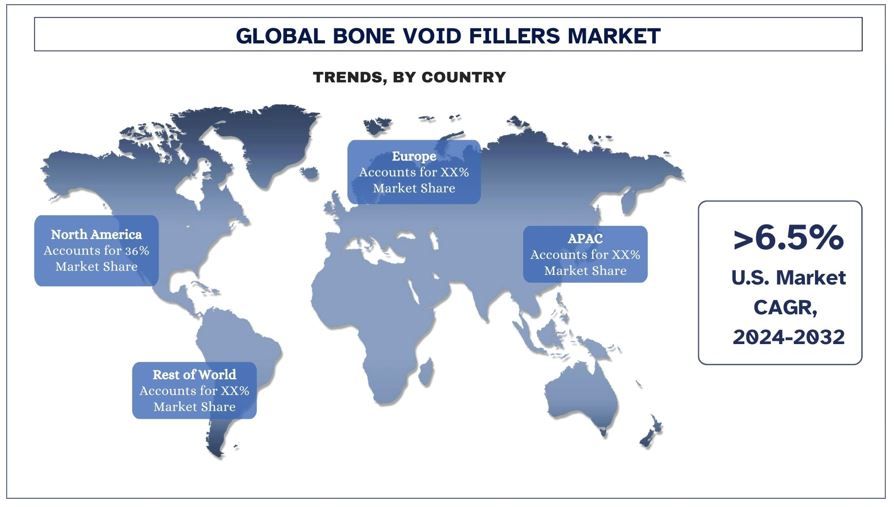
Panoramica del settore dei riempitivi per difetti ossei
Il mercato dei riempitivi per difetti ossei è competitivo, con diversi operatori di mercato globali e internazionali. I principali operatori stanno adottando diverse strategie di crescita per migliorare la propria presenza sul mercato, come partnership, accordi, collaborazioni, lanci di nuovi prodotti, espansioni geografiche e fusioni e acquisizioni. Alcuni dei principali operatori che operano nel mercato sono Stryker, Medical Device Business Services, Inc. (Johnson & Johnson), Medtronic, Zimmer Biomet, Smith+Nephew, Globus Medical, Orthofix Medical Inc., Baxter Arthrex, Inc., SeaSpine.
Notizie sul mercato dei riempitivi per difetti ossei
Nel giugno 2023, BONESUPPORT, leader emergente nel settore degli ortobiologici per la gestione delle lesioni ossee, annuncia oggi il lancio della prossima generazione del sostituto dell'innesto osseo a rilascio di antibiotico dirompente dell'azienda, CERAMENT G. Sono stati apportati miglioramenti a CERAMENT G per aumentare la facilità d'uso e ridurre l'impatto ambientale.
Nell'aprile 2023, Abyrx, Inc., azienda leader nel settore delle scienze dei biomateriali con particolare attenzione alle tecnologie terapeutiche da utilizzare durante le procedure chirurgiche, ha annunciato oggi di aver ricevuto ulteriori autorizzazioni dalla Food and Drug Administration (FDA) degli Stati Uniti per lo stucco osseo autorassorbente e regolabile MONTAGE dell'azienda sia come riempitivo per difetti ossei che come cemento osseo cranico.
Nell'ottobre 2022, Orthofix Medical Inc. ha annunciato il lancio sul mercato completo e i primi impianti di Legacy Demineralized Bone Matrix (DBM), uno stucco per riempire vuoti o lacune nei difetti ossei o nelle lesioni traumatiche della colonna vertebrale, del bacino o delle estremità.
Nel settembre 2021, Orthofix Medical Inc., azienda globale di dispositivi medici con particolare attenzione alla colonna vertebrale e all'ortopedia, ha annunciato il lancio sul mercato completo dell'impalcatura osteoconduttiva Opus Mg Set, un riempitivo per difetti ossei sintetico a base di magnesio per procedure ortopediche.
Copertura del rapporto sul mercato dei riempitivi per difetti ossei
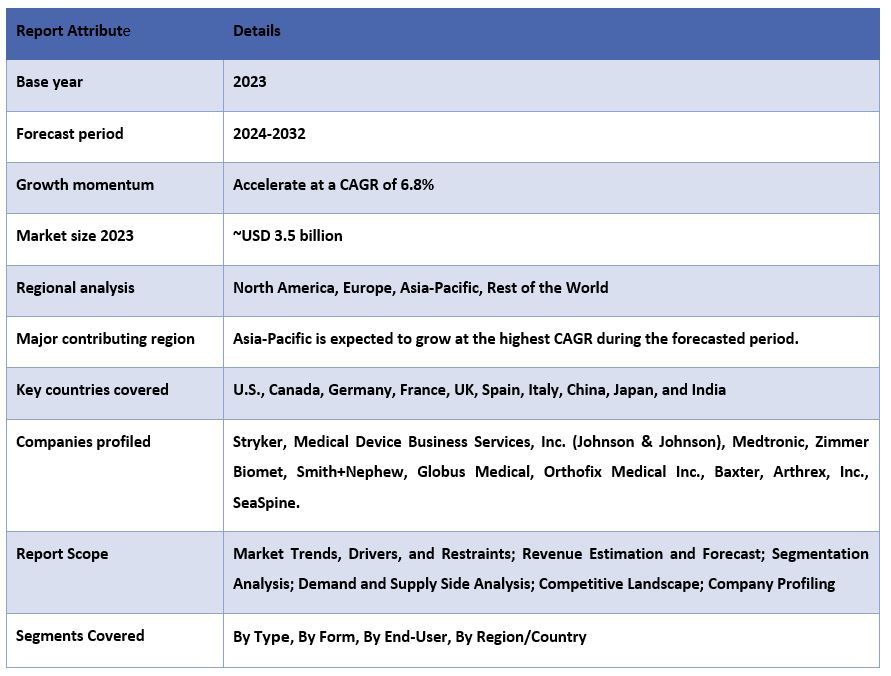
Motivi per acquistare questo rapporto:
- Lo studio include analisi di dimensionamento del mercato e previsioni convalidate da esperti chiave autenticati del settore.
- Il rapporto presenta una rapida panoramica delle prestazioni complessive del settore a colpo d'occhio.
- Il rapporto copre un'analisi approfondita dei principali concorrenti del settore con un focus primario sui principali dati finanziari aziendali, sui portafogli di prodotti, sulle strategie di espansione e sui recenti sviluppi.
- Esame dettagliato dei driver, dei vincoli, delle tendenze chiave e delle opportunità prevalenti nel settore.
- Lo studio copre in modo completo il mercato in diversi segmenti.
- Analisi approfondita a livello regionale del settore.
Opzioni di personalizzazione:
Il mercato globale dei riempitivi per difetti ossei può essere ulteriormente personalizzato in base alle esigenze o a qualsiasi altro segmento di mercato. Inoltre, UMI comprende che potresti avere le tue esigenze aziendali, quindi sentiti libero di metterti in contatto con noi per ottenere un rapporto che si adatti completamente alle tue esigenze.
Indice
Metodologia di ricerca per l'analisi del mercato dei riempitivi di vuoti ossei (2022-2032)
L'analisi del mercato storico, la stima del mercato attuale e la previsione del mercato futuro del mercato globale dei riempitivi di vuoti ossei sono stati i tre passaggi principali intrapresi per creare e analizzare l'adozione dei riempitivi di vuoti ossei nelle principali regioni a livello globale. È stata condotta un'esaustiva ricerca secondaria per raccogliere i dati storici del mercato e stimare le dimensioni del mercato attuale. In secondo luogo, per convalidare queste informazioni, sono state prese in considerazione numerose scoperte e ipotesi. Inoltre, sono state condotte anche interviste primarie esaustive, con esperti del settore in tutta la catena del valore del mercato globale dei riempitivi di vuoti ossei. Dopo l'assunzione e la convalida dei dati di mercato attraverso interviste primarie, abbiamo impiegato un approccio top-down/bottom-up per prevedere le dimensioni complete del mercato. Successivamente, sono stati adottati metodi di suddivisione del mercato e di triangolazione dei dati per stimare e analizzare le dimensioni del mercato dei segmenti e sottosegmenti del settore. La metodologia dettagliata è spiegata di seguito:
Analisi delle dimensioni storiche del mercato
Fase 1: Studio approfondito delle fonti secondarie:
È stato condotto uno studio secondario dettagliato per ottenere le dimensioni storiche del mercato dei riempitivi di vuoti ossei attraverso fonti interne aziendali come relazioni annuali e bilanci, presentazioni sulle prestazioni, comunicati stampa, ecc., e fonti esterne tra cui riviste, notizie e articoli, pubblicazioni governative, pubblicazioni della concorrenza, rapporti di settore, database di terze parti e altre pubblicazioni credibili.
Fase 2: Segmentazione del mercato:
Dopo aver ottenuto le dimensioni storiche del mercato dei riempitivi di vuoti ossei, abbiamo condotto un'analisi secondaria dettagliata per raccogliere informazioni sul mercato storico e quote per diversi segmenti e sottosegmenti per le principali regioni. I segmenti principali inclusi nel rapporto sono tipo, forma, utente finale e regioni. Sono state condotte ulteriori analisi a livello di paese per valutare l'adozione complessiva dei modelli di test in quella regione.
Fase 3: Analisi dei fattori:
Dopo aver acquisito le dimensioni storiche del mercato di diversi segmenti e sottosegmenti, abbiamo condotto un'analisi dettagliata dei fattori per stimare le dimensioni attuali del mercato dei riempitivi di vuoti ossei. Inoltre, abbiamo condotto un'analisi dei fattori utilizzando variabili dipendenti e indipendenti come tipo, forma, utente finale e regioni del mercato dei riempitivi di vuoti ossei. È stata condotta un'analisi approfondita per gli scenari di domanda e offerta considerando le principali partnership, fusioni e acquisizioni, espansione aziendale e lanci di prodotti nel settore del mercato dei riempitivi di vuoti ossei in tutto il mondo.
Stima e previsione delle dimensioni del mercato attuale
Dimensionamento del mercato attuale: sulla base di informazioni utili derivanti dai 3 passaggi precedenti, siamo giunti alle dimensioni attuali del mercato, ai principali attori nel mercato globale dei riempitivi di vuoti ossei e alle quote di mercato dei segmenti. Tutte le quote percentuali richieste e le suddivisioni del mercato sono state determinate utilizzando l'approccio secondario sopra menzionato e sono state verificate attraverso interviste primarie.
Stima e previsione: per la stima e la previsione del mercato, sono stati assegnati pesi a diversi fattori, inclusi driver e tendenze, vincoli e opportunità disponibili per le parti interessate. Dopo aver analizzato questi fattori, sono state applicate tecniche di previsione pertinenti, ovvero l'approccio top-down/bottom-up, per arrivare alla previsione di mercato per il 2032 per diversi segmenti e sottosegmenti nei principali mercati a livello globale. La metodologia di ricerca adottata per stimare le dimensioni del mercato comprende:
- Le dimensioni del mercato del settore, in termini di ricavi (USD) e il tasso di adozione del mercato dei riempitivi di vuoti ossei nei principali mercati a livello nazionale
- Tutte le quote percentuali, le suddivisioni e le ripartizioni dei segmenti e sottosegmenti di mercato
- I principali attori nel mercato globale dei riempitivi di vuoti ossei in termini di prodotti offerti. Inoltre, le strategie di crescita adottate da questi attori per competere nel mercato in rapida crescita
Convalida delle dimensioni e delle quote di mercato
Ricerca primaria: sono state condotte interviste approfondite con i Key Opinion Leaders (KOL), inclusi i dirigenti di alto livello (CXO/VP, responsabile vendite, responsabile marketing, responsabile operativo, responsabile regionale, responsabile nazionale, ecc.) nelle principali regioni. I risultati della ricerca primaria sono stati quindi riassunti ed è stata eseguita un'analisi statistica per dimostrare l'ipotesi dichiarata. Gli input della ricerca primaria sono stati consolidati con i risultati secondari, trasformando quindi le informazioni in informazioni utili.
Suddivisione dei partecipanti primari in diverse regioni
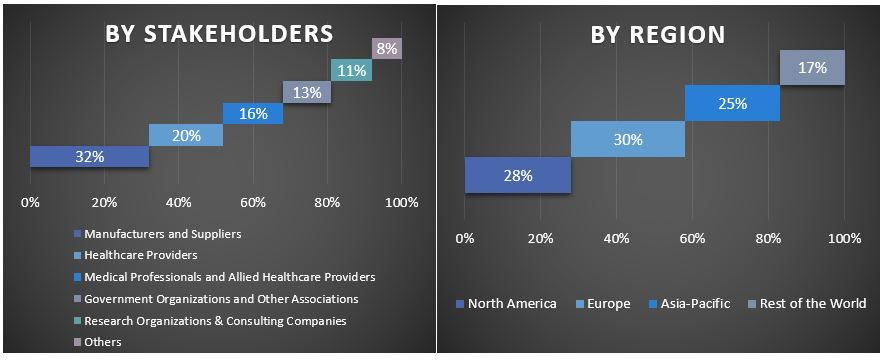
Ingegneria del mercato
La tecnica di triangolazione dei dati è stata impiegata per completare la stima complessiva del mercato e per arrivare a numeri statistici precisi per ciascun segmento e sottosegmento del mercato globale dei riempitivi di vuoti ossei. I dati sono stati suddivisi in diversi segmenti e sottosegmenti dopo aver studiato vari parametri e tendenze nel tipo, nella forma, nell'utente finale e nelle regioni del mercato globale dei riempitivi di vuoti ossei.
L'obiettivo principale dello studio sul mercato globale dei riempitivi di vuoti ossei
Le tendenze di mercato attuali e future del mercato globale dei riempitivi di vuoti ossei sono state individuate nello studio. Gli investitori possono ottenere informazioni strategiche su cui basare la propria discrezione per gli investimenti sull'analisi qualitativa e quantitativa eseguita nello studio. Le tendenze del mercato attuali e future hanno determinato l'attrattiva complessiva del mercato a livello regionale, fornendo una piattaforma al partecipante industriale per sfruttare il mercato non sfruttato per beneficiare di un vantaggio di first-mover. Altri obiettivi quantitativi degli studi includono:
- Analizzare le dimensioni del mercato attuali e previste del mercato dei riempitivi di vuoti ossei in termini di valore (USD). Inoltre, analizzare le dimensioni del mercato attuali e previste di diversi segmenti e sottosegmenti.
- I segmenti nello studio includono aree del tipo, della forma, dell'utente finale e delle regioni.
- Definire e analizzare il quadro normativo per i riempitivi di vuoti ossei
- Analizzare la catena del valore coinvolta con la presenza di vari intermediari, insieme all'analisi del comportamento dei clienti e dei concorrenti del settore.
- Analizzare le dimensioni del mercato attuali e previste del mercato dei riempitivi di vuoti ossei per la regione principale.
- I principali paesi delle regioni studiati nel rapporto includono Asia Pacifico, Europa, Nord America e il resto del mondo
- Profili aziendali del mercato dei riempitivi di vuoti ossei e le strategie di crescita adottate dagli operatori di mercato per sostenersi nel mercato in rapida crescita.
- Analisi approfondita a livello regionale del settore
Domande frequenti FAQ
Q1: Qual è l'attuale dimensione del mercato e il potenziale di crescita del mercato dei Riempitivi per Difetti Ossei?
Q2: Quali sono i fattori trainanti per la crescita del mercato dei riempitivi di difetti ossei?
Q3: Qual è il segmento con la quota maggiore del mercato dei Bone Void Fillers per tipologia?
Q4: Quali sono le principali tendenze nel mercato dei Bone Void Fillers?
Q5: Quale regione dominerà il mercato dei riempitivi per difetti ossei?
Correlati Report
I clienti che hanno acquistato questo articolo hanno acquistato anche










